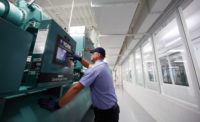In this sense, hospitals have the advantage over patients; hospitals can update their aging infrastructures.
Still, new regulations, environmental guidelines, and unplanned maintenance costs can put a severe strain on already tight hospital budgets. These increased costs make it difficult to provide a comfortable, attractive, and safe healing environment.
Piecemeal repairs weren't feasible
Methodist Healthcare-McNairy Hospital is an 86-bed hospital occupying 59,000 sq ft in rural Tennessee.The original hospital building was built in the 1960s. Several additions have been built since to accommodate growth and expansion.
Due to tightened budgets, however, the facility department was unable to properly address several areas of the hospital that experienced recurring comfort complaints.
Hospital administrator Rosemont Tyler noted that, “Our 30-year-old physical plant was in need of major updating and replacement. The location of the hospital made it difficult for service companies to address our problems on a piecemeal basis.
“These issues, coupled with the magnitude of capital required for the project, made it necessary for us to explore alternative ways to get the job done.”
“We knew some of our mechanical equipment needed to be replaced,” commented Lawrence Monroe, maintenance supervisor. “But funding was low. We chose to work with Trane because we had all Trane equipment.”
The company’s “Performance Agreement for Comfort from Trane” (PACT) program was presented as a means to address the facility’s issues using existing operating budgets, with guaranteed results.
Equipment triage
During the preliminary study, improvements were identified that were necessary to increase comfort, reduce operating costs, and manage risk.The existing generator was old and improperly sized for the hospital’s existing load; operating room comfort needed attention; and much of the mechanical equipment was reaching the end of its useful life.
Trane developed a performance contract to meet the hospital’s objectives. Monroe remarked that this was a different way of working with the equipment manufacturer. “I really felt informed and part of the team.”
The final proposal was presented to the hospital with unanimous approval. “The single point of accountability” — Trane — “made it easier to make decisions and saved a lot of our time,” said Tyler.
Among the improvements:
- A new emergency generator was installed to provide the hospital with protection from electrical outages.
- A new variable air volume (vav) system was installed to serve the operating rooms and X-ray areas.
- A lighting retrofit was completed to improve light levels and reduce utility costs.
- An electric vav reheat system was converted to steam, saving further energy.
- A building management system (Trane’s Tracer Summit®) was installed throughout the hospital to reduce operating costs and provide monitoring and control of critical areas in the hospital.
- New chillers were installed to provide more efficient and reliable cooling to patients and staff.
- And fancoil units were added to improve comfort delivery to patient rooms.
Finally, an ongoing performance management and training program is in place to ensure that projected savings and system performance occur for the term of the contract and beyond.
Pardon our dust
Of course, health care activities must continue despite construction.Through planning and communication with hospital staff, the company completed the installation without disruption to hospital operation.
“Except for normal asbestos management delays, the project ran very smoothly,” said Monroe.
The hospital now benefits from more than $826,000 in facility improvements using the program.
The project’s annual savings of $113,000 and additional first-year savings of $20,000 are funding the improvements and creating an additional stream of revenue.




